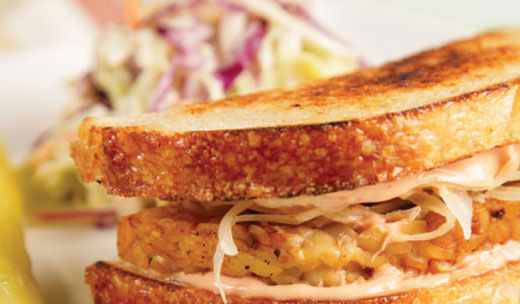Talkin' about tempeh
This article was originally published in August 2015

Tempeh may not be as widely known as tofu but it is without a doubt more nutritious, more digestible and in my opinion, more delicious. Unlike many other meat replacers, tempeh is made without any thickeners, fillers or isolated proteins — it is a whole food.
Fermented food
Tempeh (it rhymes with “gem day”) is a traditional fermented food, believed to have originated in Indonesia. Fermentation transforms the individual soybeans into a “cake” with a firm, chewy texture that is usually sliced or crumbled before cooking. Fermentation greatly enhances the digestibility of the protein, calcium and phytonutrients present in soybeans.
Protein powerhouse
Just a four-ounce serving of tempeh contains 16 grams of complete protein — the same amount as most meats! In fact, 50 percent of the calories in tempeh come from protein, which is impressive for a plant protein. Because tempeh is made from whole soybeans, it also is an excellent source of fiber (25 percent daily value) and many minerals. Tofu, on the other hand, is made from soy milk and is much lower in fiber, protein and essential minerals like magnesium, copper and manganese.
Buying tips
Tempeh is usually sold in 1/2-pound cakes, which easily provide two protein-packed servings. Tempeh has a firm texture and a noticeable “bloom” indicative of the fermentation process. Some brands add additional grains or seeds to tempeh, such as rice, millet or flaxseed, and there also are some preseasoned tempeh products such as “smoky maple bacon” tempeh.
Most tempehs are naturally gluten free; however, a few are cultured with barley and some of the preseasoned products may contain wheat. Check out options from both Turtle Island and Lightlife at PCC, including flavors such as Sesame Garlic and Organic Flax.
How to enjoy
Tempeh is an excellent meat substitute, great for sandwiches, tacos, chili or in a spaghetti sauce. It does not have an impressive flavor by itself; rather, it takes on the flavors of sauces and marinades while maintaining its chewy, firm texture during cooking.
You can marinate tempeh prior to grilling or baking to maximize flavor, or you can fry tempeh first to create a golden brown crust and then add sauces such as barbecue or honey mustard.
Get recipes for a Tempeh Reuben, Tempeh Tacos with Pickled Carrots and Radishes, Tempeh Bolognese and more. You’ll also find dishes in the PCC Deli that use tempeh, such as our PCC Southeast Asian Tempeh.
